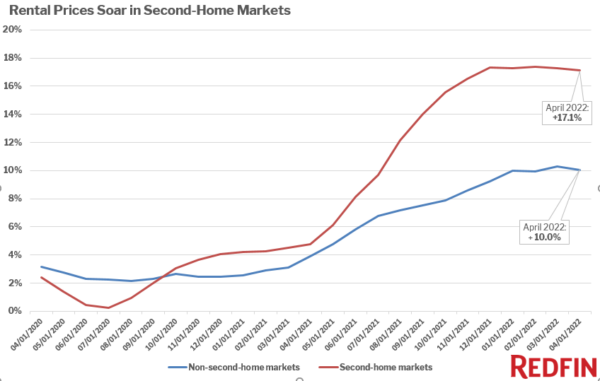As remote work prompted many Americans to relocate during the pandemic, housing costs soared in second-home hotspots even more than the rest of the country, according to a new report from Redfin.
Average rental prices rose 17.1% year-over-year nationwide to $1,893 in popular second-home markets in April. That’s compared with a 10% increase to $1,484 in places that aren’t considered second-home destinations.
In the for-sale market, typical homes in second-home markets sold for a record $516,423 in April, up 19.9% year-over-year. In non-second-home markets, prices increased 14.8% to a record $389,156. Although the chaos surrounding the housing market is slowing, prices have skyrocketed since the beginning of the pandemic.

Top 5 Second-Home U.S. Markets:
- Phoenix
- Cape Coral, Florida
- Naples, Florida
- Myrtle Beach, South Carolina
- Las Vegas
Rental prices have increased by 25% year-over-year or more in four of those five areas —excluding Myrtle Beach— and sale prices have increased by at least 25% in all five.
Prices began growing faster in second-home destinations at the end of 2020 as many affluent Americans sought to relocate and migrate away from busy metros. Mortgage-rate locks for second homes spiked in June 2020, remaining elevated through the beginning of 2022, reaching a peak of 88% above pre-pandemic levels in March 2021.
“The popularity of vacation towns has sent housing costs through the roof, making it harder for many locals to afford living in their hometowns,” said Redfin Deputy Chief Economist Taylor Marr. “The second-home boom is ending as many vacation-home buyers are priced out of the market due to historically high prices and high mortgage rates–but those same factors have already pushed locals to the sidelines. Locals in popular beach towns and vacation spots have spent the last two years competing for a limited number of homes with wealthy second-home seekers–and often losing.
One bright spot for locals who already own homes in vacation towns is that rising prices also means home equity has increased substantially.
“Many of the places where prices soared partly due to pandemic-driven second-home purchases and migration are likely to see price growth slow quicker than other parts of the country as the market cools down,” said Marr. “The outsized price growth is unsustainable, especially as demand for second homes drops.”
Phoenix is a fitting example of how the second-home boom has impacted the local housing market. In Phoenix, where there are more second homes than anywhere else in the nation, rental prices grew 32.8% year-over-year to $1,946 in April, and home prices rose 25.3% to $495,000.
“We had even more second-home buyers than usual last year from the West Coast, Midwest and Canada. It had a big impact on local buyers, many of whom don’t have the cash to compete with people coming in with a lot of cash from out of town,” said Phoenix Redfin agent Heather Mahmood-Corley. “A lot of out-of-towners were able to pay in all cash, make large down payments, waive the appraisal contingency, and/or bid up prices–something local buyers often don’t have the resources to do.”
Prices have also increased sharply in Cape Coral, Florida and Naples, Florida —the next-most prevalent second-home markets— where rental prices grew 41% and 37.7%, while sale prices rose 38.2% and 37.6%.
Mortgage applications for second homes in Phoenix increased 23% from 2018-2019 to 2020-2021, and they increased even more in Florida: 59% in Cape Coral and 75% in Naples. Applications were up 38% overall in Myrtle Beach and 16% in Las Vegas.
To view the full report, including charts and methodology, click here.
Article Source [www.dsnews.com]



